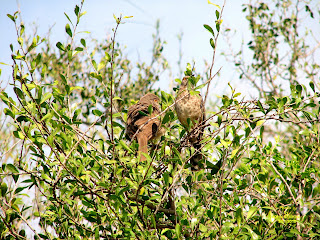

FOAM LAKE BIRDING
No. 78
It looks like spring really has arrived at last. The weather is summer-like in all aspects. To me, the most pleasant part is the arrival of summer birds from Mexico such as the Black Bellied Whistling Ducks and the Scissor Tailed Flycatcher, and the departure to the north of wintering birds such as the White Pelican and most species of ducks.
Because mating season is well on its way down here, male birds are in full song staking out their breeding territories. One family, the mimics or mimids, really stand out in this respect. Down here that includes three species: the Mocking Bird and, this week’s featured birds, the Curved Billed and Long Billed Thrashers. Unlike the Mocking Birds, the Thrashers do not imitate anything to any extent; but, like the Mocking Birds, they are excellent songsters. All three are common down here.
Thrashers often feed on the forest floor by swinging their heads vigorously from side to side scattering fallen leaves and other debris with their bills thereby exposing insects and worms. This thrashing about on the ground and throwing litter about gives them their name of thrashers.
Both thrashers sing from treetops or other vantage points and can be approached quite closely. That is why I was able to get these pictures only minutes apart. Their songs are forceful and have a robin-like quality, but with a bit more of a warble to them.
The name, Curved Billed, is a bit misleading as all thrashers have curved bills and some species’ bills are more curved than that of the Curved Billed. Most thrashers’ songs are quite similar and it takes a bit of practice to tell them apart, but the Curved Billed has a unique two part whistle that is eerily similar to the “wolf” whistle that humans use to express their approval of an attractive person of the opposite sex. Among humans this practice has more or less stopped due to the pressures of political correctness. It is a good thing the Curved Billed Thrasher has not changed its vocalizations as its two part call is diagnostic in identifying it. It occurs in the American southwest from California to the Gulf of Mexico and as far north as southern Colorado.
On the other hand, the Long Billed Thrasher is a bird of the southern tip of Texas, only, where it is common in thickets and brush. Like the Curved Billed, its name is also a bit of a misnomer. All thrashers, but two, have long bills and some have bills that are longer than the Long Billed. Perhaps ornithologists ran out of common English names and filled the void with almost anything at all. It is a thought.
Even without vocalizations it is quite easy to tell the two apart. The Curved Billed’s grey breast is only lightly striped (appears faintly spotted) and the head, back and tail are brownish grey; the Long Billed’s white breast is heavily striped with black and its head, back and tail are a rich brown. Overall, the Curved Billed is quite drab in comparison to the Long Billed. Both have yellow to orange eyes.
This week’s photos show their characteristics quite clearly. The Curved Billed Thrashers have already paired off; the Long Billed is not quite so lucky, yet.



